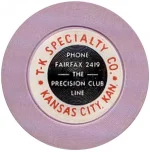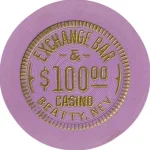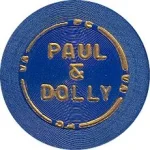I haven’t done a deep dive, nor found any definitive sources
But I believe they’re more like compressed clay than like plastic, but uhh… this is not well supported.
Some were made by Hunt in Illinois who made the various chain mold chips, of which some were compression clay and others definitely more on the plastic side. They also made checkers and backgammon tokens that were more plastic.
I forget the company that made the machined chips based in Louisiana … similar to these pictured here, but that might offer some evidence if dug up
Eisenstadt did a lot of great research, but his claim that the Hunt Co. made these chips is wrong. Hunt never made or sold either version of them. I think he is confusing it with a different circular design chip that Hunt did sell.
The Burt Company made both versions of the above Circles Mold chips between the late 1940s and the mid (possibly late)1950s. I don't think anyone else made them. They are compression clay chips, although the composite formula is slightly more plastic than Burt's later chips.
Unlike most chip molds, the mold was an open mold. Any distributor could use it, and several did. Below are gambling supply distributor advertising chips from T. K. Specialty and Frank Walters. Both were active in the late 1940s and early 1950s. Frank Walters closed shop in 1956. (You may need to click on the thumbnail pics to see the circle grooves.)


I believe that the Sawtooth Club chip, and Gus's FSL and THK chips were all hot stamped by the Salt Lake Card Co. (Salt Lake, Utah) a gambling supply company founded and owned by Edward A. Stroud from 1949, until his sudden death in 1958. Stroud used both versions of Circles mold, and below is one of his advertising chips. Note that the advertising chip has the same diamond hot stamp pattern in the large circle gap as Gus' FSL chip.

Most serious gambling supply companies of that era had their own proprietary edge mold design to protect their customers from counterfeit "ringed in" chips. If they used an open mold, and hot-stamped it, it was still possible for a patient counterfeiter to order the chips from another distributor, and have the hot stamp duplicated. Instead of getting an expensive custom edge mold chip design, I think that Stroud tried to get around that problem by creating a hot stamp that would be hard for anyone to duplicate. Its hard to precisely center a hot stamp on a chip, but he somehow managed to get it inside that tiny groove every time.
Below are some more chips that I believe Stroud hot-stamped. It may be hard to see on the thumbnail pics, but all are on the Circles mold. I've never seen this style of hot stamp on anything other than the two versions of the Circles mold.



It's possible that other distributors used Stroud's style of hot stamping, but I have not seen evidence of it. Also, in relation to the Sawtooth Club chip, Ketchum is in southern Idaho, and Idaho borders Utah to the north. Salt Lake City is just a four-hour drive away.







